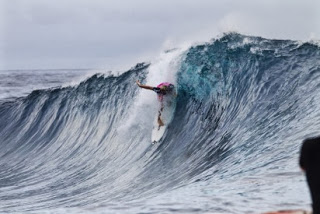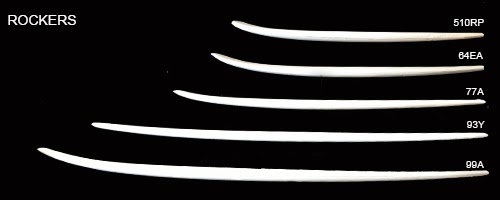 Nov
20
Nov
20
Rockers And Bottom Curves, Natural Or Custom!
- November 20, 2013
- 0 Comment(s)
“Rocker” is the dimensional curve along the bottom, top, and rail of the surfboard, usually referenced from nose to tail. Not one rocker is universally better than another. Rocker is just one instrument in an orchestra of design elements that contribute to a successful surfboard shape. There are, however, some basic rules of hydrodynamics that one must consider in order to understand the function of rocker.
 |
| Ace Buchan uses every bit of his rocker to make this steep drop! |
Firstly, the more rocker or bottom curve that a design has, the more maneuverability but less speed the design holds. The added degree of rocker pushes water, and consequently reduces overall speed. On the other hand, that added curve allows the design to turn in a tighter radius. Additionally, rocker allows designs to fit into steep waves without submerging the nose, i.e., hollow waves like Pipeline.
Conversely, flatter rocker brings more speed but also a decrease in maneuverability. The flatter rocker allows more of the board’s surface to be in contact with the water and therefore generate more planing speed. Generally, flatter bottomed designs are applied to boards that will be surfed in small or gutless waves, i.e, fish boards. And, of course, with the flatter, straighter rocker the board will feel more stiff and will be more difficult to turn.
 |
| Cut and ready to glue up |
US Blanks are molded with a “Natural Rocker” unique to each blank and specified in the blank description within their catalog. The Natural Rocker is designed to accommodate a variety of designs.
While the blank is molded with a Natural Rocker, there are two additional opportunities to adjust the rocker before finishing the surfboard design. Once, when the blank is ordered and secondly, when the shaper is shaping the board.
Each blank can be ordered with any desired rocker adjustment. The blank is cut down the center lengthwise, stringer is chosen and the blank is glued with the rocker adjustment in place. The adjustments are written in a formula beginning with the nose (noted with an “N”) adjustment and followed by the tail adjustment (noted with a “T”). Us Blanks use the deck line to adjust the rocker which is referenced from the Natural Rocker, i.e., an adjustment of +1/4”N -1/4”T would indicate bending the foam upward to add one quarter inch of rocker to the nose and then bending the tail downward one quarter inch to decrease the rocker in the tail.
 |
| A few of US Blanks Public Rocker Templates! |
Once the blank is ordered with the requested rocker adjustment, the shaper can still make further refinements to the rocker of the final surfboard design. The shaper can carve subtle adjustments to the board’s rocker within the design of the given blank, but they cannot permanently bend the blank at this point. This is why blank selection is an important first step. It provides a flexible yet specific foam structure that most closely resembles the final design that the shaper will implement.
It is important to remember that the resulting affect of any rocker adjustment is influenced by other design elements like rail contours, fin set up, and concaves. Finding the exact right rocker for a surfer, a given board and specific type of wave is the result of thorough communication between the surfer and the shaper.
Thanks to US Blanks for this thorough explanation!

